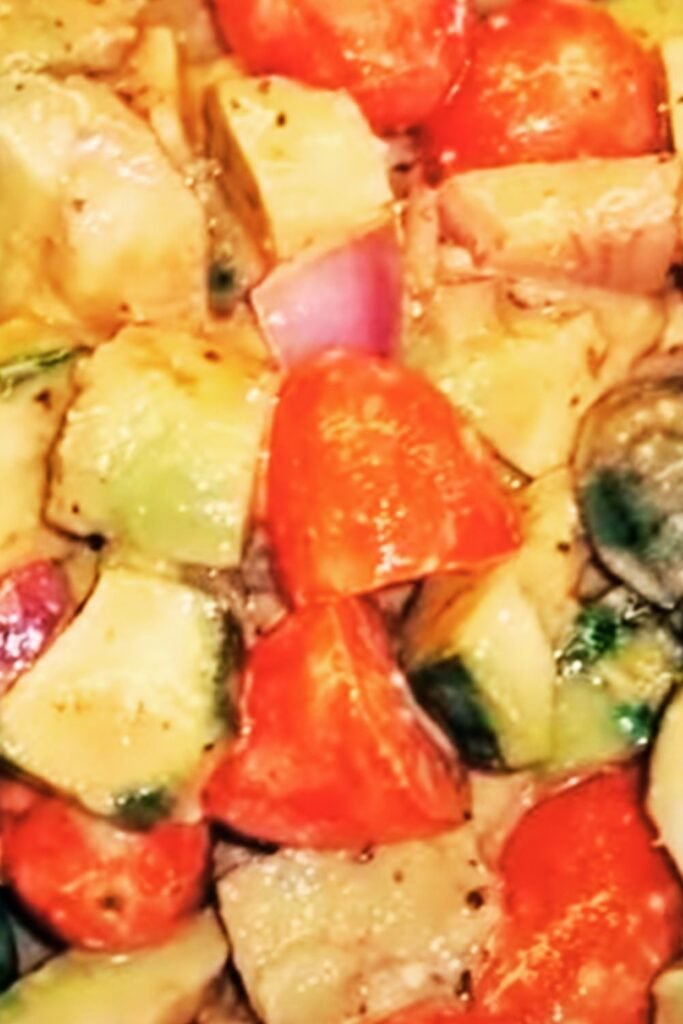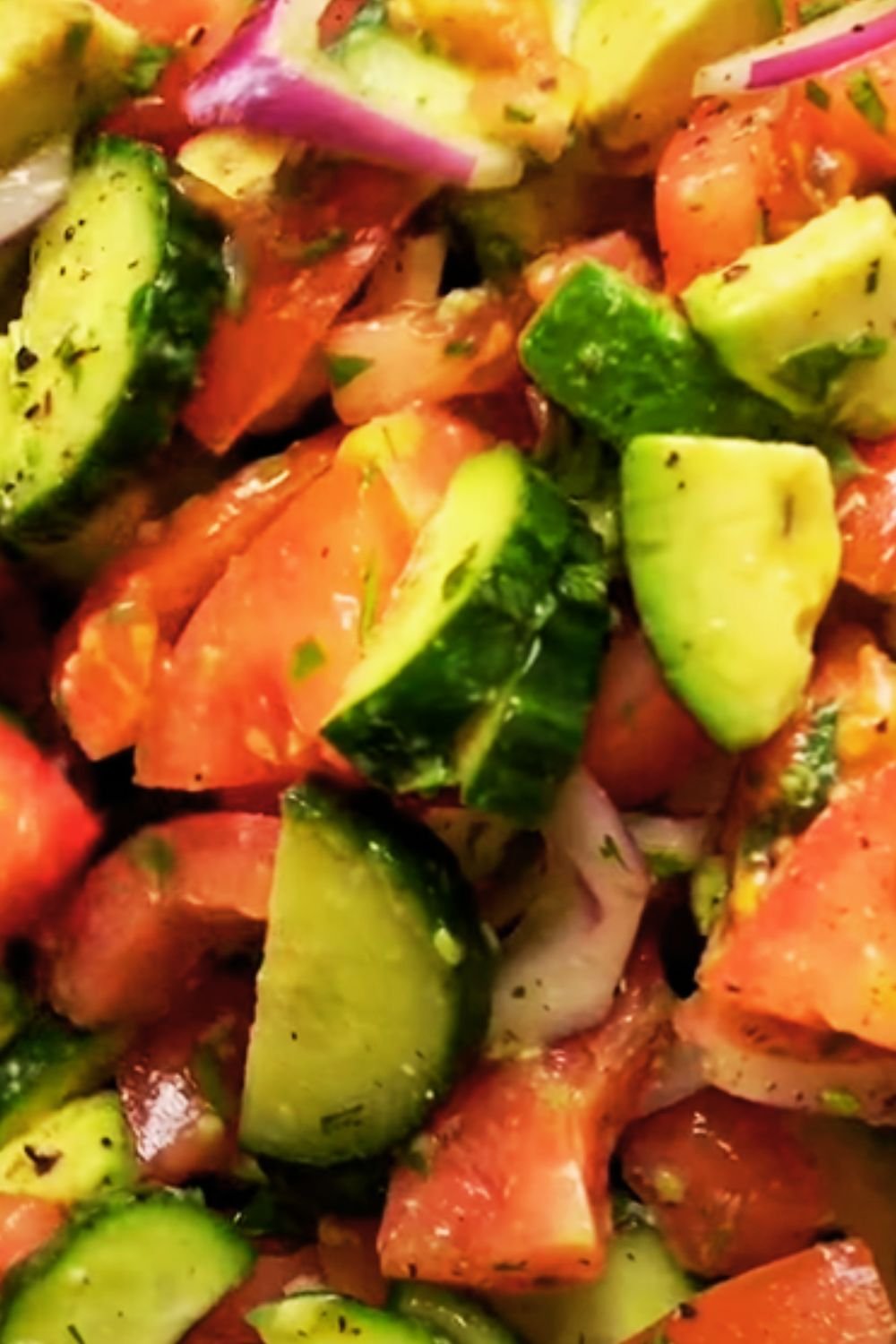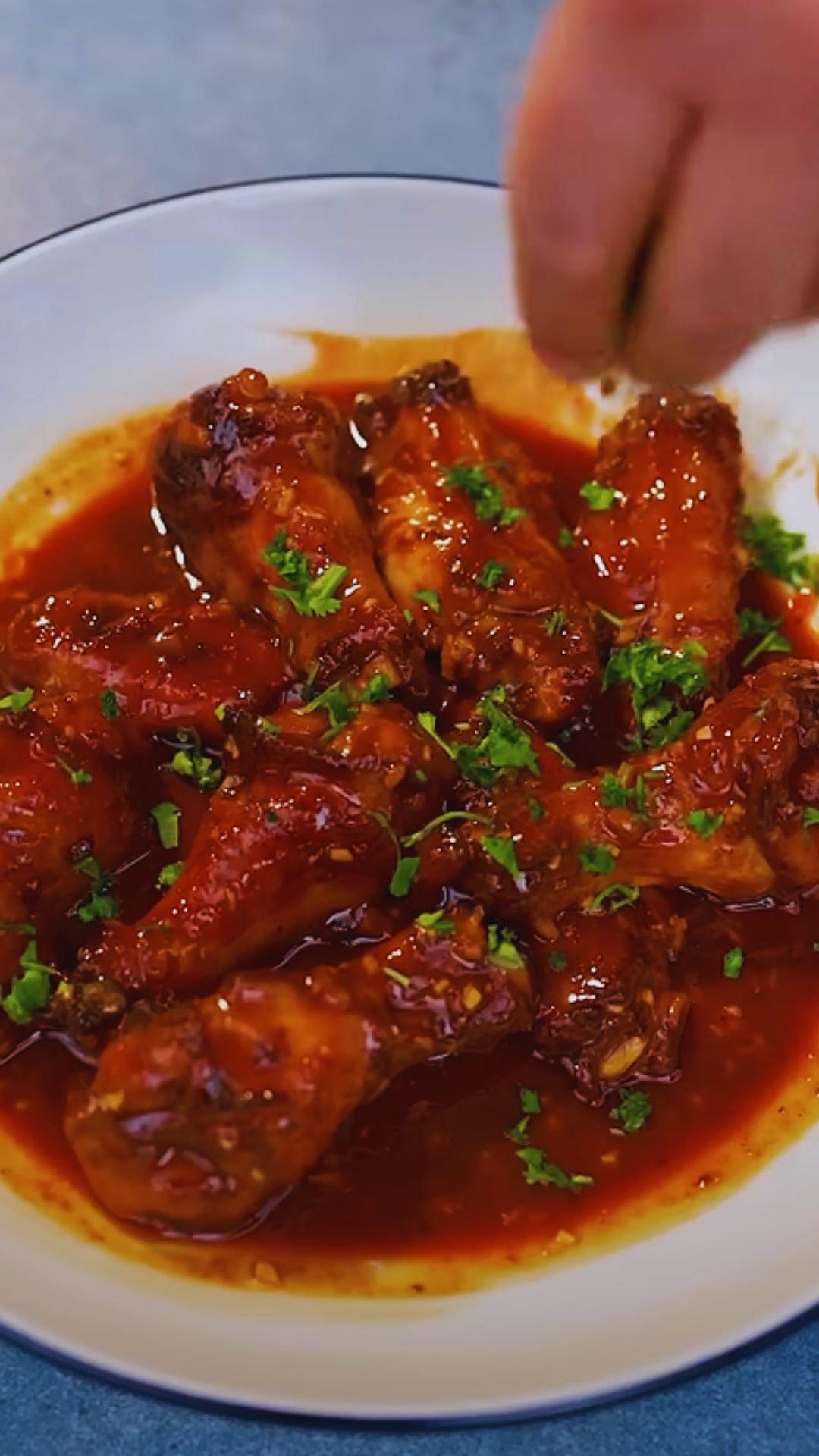When I first discovered the magic of combining crisp cucumbers, juicy tomatoes, and creamy avocados in one bowl, I knew I’d stumbled upon something extraordinary. This cucumber tomato avocado salad has become my go-to recipe for everything from casual weeknight dinners to elegant summer gatherings. There’s something absolutely perfect about the way these three ingredients complement each other – the refreshing crunch of cucumber, the burst of sweetness from ripe tomatoes, and the rich, buttery texture of avocado.
What makes this salad truly special isn’t just its incredible taste, but also its versatility and nutritional powerhouse status. I’ve served this at barbecues where it disappeared within minutes, packed it for office lunches that made my colleagues envious, and even enjoyed it as a light dinner on those sweltering summer evenings when cooking felt impossible.
Why This Salad Will Transform Your Kitchen Game
I’ve been making variations of this salad for years, and let me tell you, it never gets old. The beauty lies in its simplicity – you don’t need complicated techniques or exotic ingredients. Just fresh, quality produce and a few pantry staples transform into something that tastes like it came from a high-end restaurant.
The nutritional benefits alone make this salad worth incorporating into your regular meal rotation. Cucumbers provide hydration and essential minerals, tomatoes deliver lycopene and vitamins, while avocados contribute healthy fats that help your body absorb all those fat-soluble vitamins. It’s like nature’s perfect multivitamin in salad form.
Essential Ingredients Breakdown
Primary Components:
- Cucumbers: I prefer English cucumbers for their thin skin and minimal seeds, but regular cucumbers work perfectly fine when peeled
- Tomatoes: Cherry tomatoes, grape tomatoes, or diced regular tomatoes all work beautifully
- Avocados: Choose avocados that yield slightly to gentle pressure but aren’t mushy
Dressing Elements:
- Extra Virgin Olive Oil: The foundation of our dressing
- Fresh Lemon Juice: Brightens flavors and prevents avocado browning
- Red Wine Vinegar: Adds tangy depth
- Garlic: Fresh minced garlic makes all the difference
- Fresh Herbs: Basil, parsley, or cilantro elevate the entire dish
Seasoning Essentials:
- Sea Salt: For bringing out natural flavors
- Black Pepper: Freshly ground works best
- Optional Add-ins: Red onion, feta cheese, or pine nuts
Complete Recipe Instructions
Preparation Steps
Step 1: Vegetable Preparation I always start by washing all my vegetables thoroughly under cold running water. For the cucumbers, I slice them into half-moons about ¼-inch thick. If you’re using regular cucumbers, peel them first as the skin can be tough and bitter.
Step 2: Tomato Handling For cherry or grape tomatoes, I simply halve them to release their juices into the salad. If using regular tomatoes, I dice them into bite-sized pieces, removing any tough stem areas. Here’s a pro tip I learned: salt your tomatoes lightly and let them sit for 10 minutes to draw out excess moisture.
Step 3: Avocado Technique This is where timing becomes crucial. I cut my avocados just before serving to maintain their beautiful green color and prevent browning. Cut each avocado in half, remove the pit, and dice into chunks roughly the same size as your other vegetables.
Step 4: Dressing Creation In a small bowl, I whisk together 3 tablespoons of extra virgin olive oil, 2 tablespoons of fresh lemon juice, 1 tablespoon of red wine vinegar, and 1 minced garlic clove. The key is whisking vigorously to create an emulsion.
Step 5: Assembly Magic Gently combine all vegetables in a large serving bowl. Pour the dressing over the vegetables and toss carefully with clean hands or large spoons. I prefer using my hands because it allows me to feel the ingredients and avoid over-mixing, which can turn the avocado mushy.
Nutritional Analysis Table
| Nutrient | Per Serving (1 cup) | Daily Value % | Health Benefits |
|---|---|---|---|
| Calories | 185 | 9% | Low-calorie, nutrient-dense |
| Total Fat | 14g | 18% | Mostly healthy monounsaturated fats |
| Saturated Fat | 2g | 10% | Heart-healthy profile |
| Fiber | 7g | 25% | Supports digestive health |
| Vitamin K | 25mcg | 21% | Bone health, blood clotting |
| Vitamin C | 18mg | 20% | Immune system support |
| Folate | 85mcg | 21% | Cell division, DNA synthesis |
| Potassium | 485mg | 10% | Heart health, blood pressure |
| Lycopene | 3.2mg | N/A | Antioxidant, cancer protection |
Ingredient Substitutions Guide
| Original Ingredient | Substitution Options | Flavor Impact | Usage Notes |
|---|---|---|---|
| English Cucumber | Regular cucumber, zucchini | Minimal change | Peel regular cucumbers |
| Cherry Tomatoes | Grape tomatoes, diced regular | Slightly different texture | Adjust cutting size accordingly |
| Avocado | Hearts of palm, cucumber | Significant texture change | Won’t provide same creaminess |
| Lemon Juice | Lime juice, white wine vinegar | Citrus profile changes | Use same quantity |
| Red Wine Vinegar | Apple cider vinegar, balsamic | Flavor complexity varies | Start with less balsamic |
| Fresh Herbs | Dried herbs | Less vibrant flavor | Use 1/3 the amount |

Advanced Preparation Techniques
Over the years, I’ve discovered several techniques that elevate this simple salad from good to absolutely outstanding. One method I swear by is the salt-and-drain technique for cucumbers. After slicing them, I toss the cucumber pieces with a teaspoon of salt and let them drain in a colander for 15 minutes. This removes excess water that could make the salad soggy.
Another game-changing technique involves roasting the garlic before adding it to the dressing. I wrap a whole garlic bulb in foil with a drizzle of olive oil and roast it at 400°F for 30 minutes. The resulting garlic is sweet, mellow, and adds incredible depth to the dressing.
For the tomatoes, I’ve learned that different varieties bring unique characteristics. Cherry tomatoes provide bursts of sweetness, while heirloom varieties add complex flavors and beautiful colors. I sometimes mix different types for visual appeal and taste complexity.
Seasonal Variations I Love
Spring Version: I add fresh peas, radish slices, and mint leaves. The peas provide a sweet pop, radishes add peppery crunch, and mint brings fresh coolness.
Summer Peak: This is when I go all out with the best tomatoes available. I layer in different tomato varieties, add fresh corn kernels, and include edible flowers for stunning presentation.
Fall Adaptation: I incorporate roasted butternut squash cubes, toasted pumpkin seeds, and sage leaves. The warm, earthy flavors complement the fresh vegetables beautifully.
Winter Comfort: I add roasted beets, toasted walnuts, and dried cranberries. The sweetness of beets and cranberries balances the other flavors perfectly.
Storage and Make-Ahead Strategies
One question I get constantly is whether this salad can be made ahead. The answer is nuanced. I can prepare all the vegetables except the avocado up to 24 hours in advance. I store the prepped cucumbers and tomatoes separately in the refrigerator, covered tightly.
The dressing can be made up to a week ahead and stored in the refrigerator. I actually prefer it after it’s had time to meld – the flavors become more harmonious.
For the avocado, I have a secret trick: if I must add it ahead of time, I toss it with extra lemon juice and store it separately. The acid prevents browning for several hours.
When packing this salad for lunch or picnics, I use the layering method. Dressing goes on the bottom, then sturdy vegetables like cucumbers and tomatoes, and finally the delicate avocado on top. This prevents everything from getting soggy.
Flavor Enhancement Secrets
Through years of experimenting, I’ve discovered several ways to amplify the flavors in this salad. One of my favorite techniques is creating flavored oils. I gently warm olive oil with herbs like basil or thyme, then let it cool completely before using it in the dressing. The oil carries the herb essence throughout the entire salad.
Another technique involves using different acid sources. While lemon juice is classic, I sometimes use lime juice for a more tropical feel, or even a splash of champagne vinegar for elegance. Each acid brings its own character to the dish.
I’ve also experimented with different salt types. Sea salt is my standard, but pink Himalayan salt adds a subtle mineral complexity, and smoked salt can transform the entire flavor profile of the salad.
Serving Suggestions and Pairings
This salad works beautifully as a side dish or can be transformed into a complete meal with the right additions. As a side, it pairs wonderfully with grilled chicken, fish, or even vegetarian proteins like grilled tofu or tempeh.
For complete meals, I often add protein directly to the salad. Chickpeas, hard-boiled eggs, grilled shrimp, or even leftover roasted chicken all work beautifully. The key is adding proteins that won’t overpower the fresh, clean flavors of the vegetables.
I love serving this salad with warm, crusty bread or pita chips for textural contrast. The bread helps soak up the delicious dressing that pools at the bottom of the bowl.
For beverages, I find that sparkling water with a splash of citrus complements the salad perfectly. The bubbles and acidity enhance the fresh flavors without competing with them.
Troubleshooting Common Issues
Problem: Watery Salad This usually happens when vegetables release too much moisture. My solution is the salt-and-drain method I mentioned earlier, plus using a slotted spoon when serving to leave excess liquid behind.
Problem: Bland Flavor Almost always, this means not enough acid or salt. I taste and adjust the dressing, often adding more lemon juice or a pinch more salt. Remember, vegetables need more seasoning than you might think.
Problem: Brown Avocado Prevention is key here. I always add avocado last and ensure there’s enough acid in the dressing. If some browning occurs, I gently remove the affected pieces and add fresh avocado.
Problem: Overpowering Garlic Raw garlic can be aggressive. If this happens, I remove the garlic pieces if possible, or balance the flavor with a touch of honey or maple syrup in the dressing.
Health Benefits Deep Dive
This salad is nutritionally impressive, but the benefits go beyond basic vitamins and minerals. The combination of ingredients creates synergistic effects that enhance nutrient absorption and provide comprehensive health benefits.
The lycopene in tomatoes becomes more bioavailable when combined with the healthy fats from avocado and olive oil. This means your body can actually use more of this powerful antioxidant when these ingredients are eaten together.
Cucumbers are incredibly hydrating, containing about 96% water, plus electrolytes like potassium and magnesium. This makes the salad particularly beneficial during hot weather or after exercise.
The fiber content from all three main ingredients supports digestive health and helps maintain stable blood sugar levels. The combination of soluble and insoluble fiber provides comprehensive digestive benefits.
Avocados contribute folate, which is crucial for cell division and DNA synthesis. This makes the salad particularly beneficial for pregnant women or anyone looking to support cellular health.
Cultural Variations and Global Inspiration
While my version draws from Mediterranean influences, similar salads exist in cuisines worldwide. In Middle Eastern cuisine, fattoush incorporates similar vegetables with the addition of sumac and toasted pita bread for crunch.
Greek variations often include feta cheese and olives, adding salty, briny flavors that complement the fresh vegetables beautifully. The Greek approach also typically uses oregano instead of basil.
Mexican-inspired versions might include jalapeños, cilantro, and lime juice, creating a completely different flavor profile while maintaining the same fresh, healthy foundation.
I’ve experimented with Asian influences too, using rice vinegar and sesame oil in the dressing, plus adding edamame and sesame seeds for protein and crunch.
Questions and Answers
Q: How long will this salad stay fresh in the refrigerator? A: Without avocado, the salad keeps well for 2-3 days refrigerated. With avocado, I recommend consuming within 24 hours for best quality, though it’s still safe to eat for 2-3 days.
Q: Can I use frozen vegetables for this recipe? A: I don’t recommend frozen vegetables for this salad. The texture becomes too soft when thawed, and you’ll lose the important crunch that makes this salad so appealing.
Q: What’s the best way to choose ripe avocados? A: Look for avocados that yield slightly to gentle pressure but don’t feel mushy. The skin should be dark green to black, and they shouldn’t have any dark sunken spots, which indicate overripeness.
Q: Is there a way to make this salad vegan? A: This salad is naturally vegan as written! All the ingredients are plant-based, making it perfect for vegan diets without any modifications needed.
Q: Can I add cheese to this salad? A: Absolutely! Feta cheese is my favorite addition – it adds saltiness and creaminess that complements the vegetables beautifully. Fresh mozzarella balls or goat cheese also work wonderfully.
Q: How can I make this salad more filling? A: Add protein like chickpeas, hard-boiled eggs, grilled chicken, or quinoa. You can also include nuts or seeds for healthy fats and extra texture.
Q: What should I do if my avocado is too hard? A: Place it in a paper bag with a banana or apple for 1-2 days. The ethylene gas from the fruit will speed up ripening. For emergency ripening, wrap in foil and bake at 200°F for 10-15 minutes.
Q: Can I make the dressing ahead of time? A: Yes! The dressing actually improves with time as the flavors meld together. Store it in the refrigerator for up to a week and whisk before using.
Q: Why do my cucumbers always make the salad watery? A: Cucumbers naturally contain a lot of water. Salt them lightly and let them drain in a colander for 15 minutes before adding to the salad. This removes excess moisture.
Q: What’s the best knife for cutting avocados? A: I use a sharp paring knife or a small chef’s knife. The key is keeping your knife sharp – dull knives can mash the avocado instead of cutting cleanly through it.
This cucumber tomato avocado salad has truly become one of my signature dishes, and I hope it becomes one of yours too. The beauty lies in its simplicity, versatility, and the way it celebrates the natural flavors of fresh, quality ingredients. Whether you’re serving it at a summer barbecue, packing it for lunch, or enjoying it as a light dinner, this salad delivers satisfaction in every bite.

